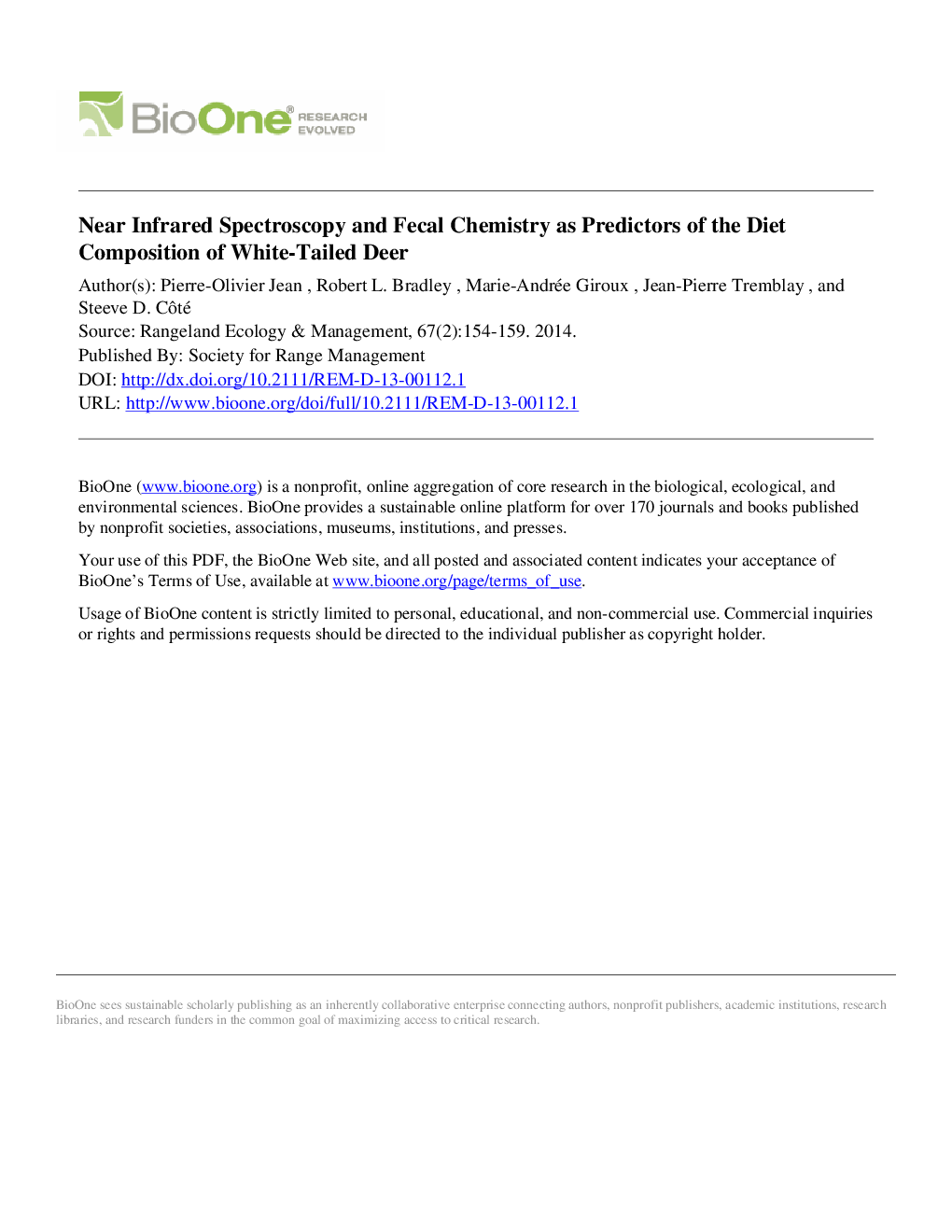| کد مقاله | کد نشریه | سال انتشار | مقاله انگلیسی | نسخه تمام متن |
|---|---|---|---|---|
| 4404487 | 1307166 | 2014 | 7 صفحه PDF | دانلود رایگان |
عنوان انگلیسی مقاله ISI
Near Infrared Spectroscopy and Fecal Chemistry as Predictors of the Diet Composition of White-Tailed Deer
ترجمه فارسی عنوان
در نزدیکی طیف سنجی مادون قرمز و شیمی مدفوع به عنوان پیش بینی از ترکیب رژیم غذایی گاو سفید
دانلود مقاله + سفارش ترجمه
دانلود مقاله ISI انگلیسی
رایگان برای ایرانیان
کلمات کلیدی
موضوعات مرتبط
علوم زیستی و بیوفناوری
علوم کشاورزی و بیولوژیک
علوم کشاورزی و بیولوژیک (عمومی)
چکیده انگلیسی
Overbrowsing by white-tailed deer (Odocoileus virginianus Zimmermann) on Anticosti Island (Canada) created a need to develop efficient methods for estimating their foraging patterns. We tested the ability of near infrared (NIR) spectra of feces and of fecal chemical properties to predict diet composition of different individuals. We first used a principal component-based discriminant analysis to sort the NIR spectra of fecal samples (nâ=â102) obtained from two groups of captive deer that had been fed two different diets. The diets differed only in their relative abundance of balsam fir (Abies balsamea [L.] P.Mill.) and white spruce (Picea glauca [Moench] Voss.) foliage. The calibrated model allowed us to assign 28 of 30 validation fecal samples (93.3 %) to the correct diet. In a second study, we attempted to estimate the proportion of coniferous, deciduous, herbaceous, and lichenous forages in diets of free-ranging white-tailed deer, as determined by fecal microhistology. Both NIR spectra and chemical properties of feces were used as predictors of diet composition. NIR spectra were analyzed using partial least-squares regression (PLSR), whereas fecal chemical properties were analyzed using mixed-linear regressions (MLRs). The PLSR models were robust (R2â=â0.89; ratio of prediction to deviationâ=â3.2) for predicting the amount of coniferous fragments, but not for predicting the relative amounts of balsam fir, white spruce, and deciduous and lichenous fragments within feces. MLR models revealed a positive relationship (47% variance explained) between acid detergent lignin (ADL) and coniferous fragments within feces. ADL and cellulose explained 24% of variance in deciduous fecal fragments, whereas ADL alone explained 22% of variance in balsam fir fecal fragments. These results suggest that NIR spectroscopy and fecal chemical properties have several applications on Anticosti Island, such as measuring the degree of variation in diets within a given home range or determining dietary conifer intake during winter.
ناشر
Database: Elsevier - ScienceDirect (ساینس دایرکت)
Journal: Rangeland Ecology & Management - Volume 67, Issue 2, March 2014, Pages 154-159
Journal: Rangeland Ecology & Management - Volume 67, Issue 2, March 2014, Pages 154-159
نویسندگان
Pierre-Olivier Jean, Robert L. Bradley, Marie-Andrée Giroux, Jean-Pierre Tremblay, Steeve D. Côté,
